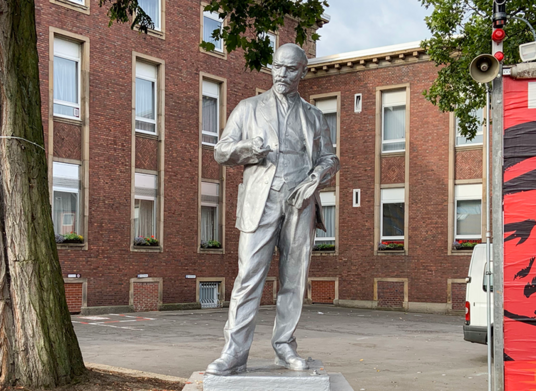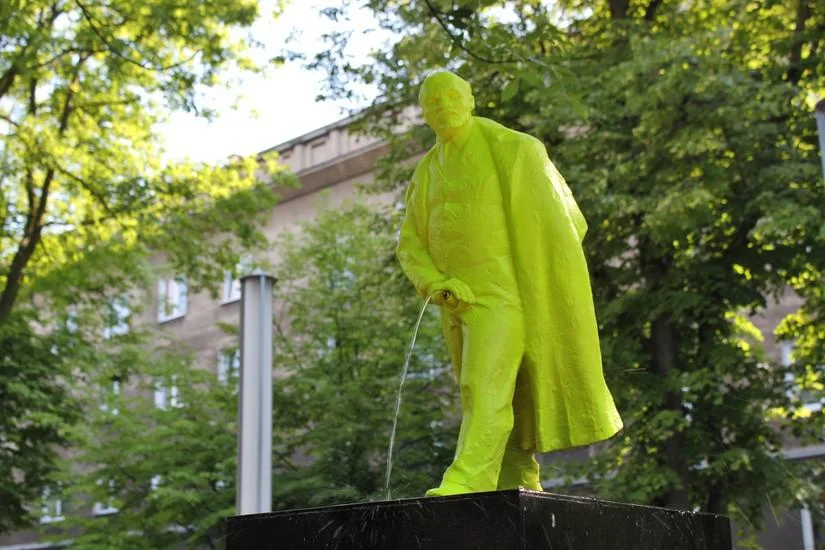This website uses different cookies. We use cookies to personalise content, provide social media features, and analyse traffic to our website. Some cookies are placed by third parties that appear on our pages. You can find more information and options to choose from in our Privacy Policy and Configurations for usage.
Multiperspective Memorials: The story of the most recent Lenin statue
Noah Harris

Lenin Statue, Gelsenkirchen, Germany
It was erected in Gelsenkirchen, Germany, in 2020. The statue of Lenin, actually constructed in Czechoslovakia in the 1950s, was erected in the West German city in June 2020, following an initiative by the Marxist-Leninist Party of Germany (MLPD), a small party with around 3000 members based in the city. This was a controversial decision, in which the memory and symbolism of Lenin were contested.
In defending the decision to erect the statue outside the MLDP’s offices, the local chairperson of the party, Gabi Fechtner, declared: "Lenin was an ahead-of-his-time thinker of world-historical importance, an early fighter for freedom and democracy". For some such as the MLPD, Lenin is a symbol that another world outside of neoliberal capitalism is possible and signifies hope. It is not just his role in the Russian revolution that is remembered, but also his support in the early years of the Soviet Union for a number of progressive initiatives, such as for providing free education, limiting the workday to 8 hours and legalising abortion. Supporters also refer to the fact that Lenin initiated the Declaration of the Rights of the Peoples in Russia (‘Декларация прав народов России’), that gave greater cultural, linguistic and overall rights to non-Russian ethnic groups in the Soviet Union.
This is a positive memory of Lenin that famous leftist academic scholar Slavoj Žižek referred to in a recent interview with Russian publication ‘Meduza’. When asked whether he would reconsider his positive opinion of Lenin due to Russia’s invasion of Ukraine. In response, whilst outright criticising Russia’s invasion and after calling for greater western backing of Ukraine, he contested the idea that Lenin symbolised Russian oppression by telling the interviewer that Lenin was a critic of Russian chauvinism and supported greater autonomy for national republics.However, this positive memory of Lenin is controversial and, like in Gelsenkirchen, is often contested. The decision to erect the statue of Lenin in 2020 received international media coverage and led to local politicians, such as Sascha Kurth, the leader of the local CDU party, to strongly condemn the statue’s erection. For people like Kurth, Lenin carries a very different symbolism. Rather than be a symbol for hope and equality, Lenin is, on the contrary, viewed as a symbol of oppression. This is something that Kurth directly alluded to when he stated, "We are opposed in principle to erecting portraits of people in the cityscape in whose name or in whose ideology so much suffering has been and is being spread."
As a figurehead and visual representation of the Soviet Union, Lenin represents, for people like Sascha Kurth, all of the worst parts of the Soviet Union: repression, internment camps and a lack of free speech. In the years since the Soviet Union collapsed, the very action of removing or adapting statues of Lenin has for many been a therapeutic way to liberate themselves from the past.
One example of this can be found in the Nowa Huta district of Krakow, Poland. In 2014, local residents decided to replace the once giant 2.7 metre statue of Lenin with a much smaller, reconstructed 27 inch statue of a lurid green Lenin urinating from his plinth. In describing the significance of the new statue, co-creator Bartosz Szydlowski spoke about how this ‘new’ statue was not just intended to make people laugh, but in doing so would also serve as a way to help locals comes to terms with their own trauma: “are we capable of ascribing a funnier, surrealist meaning to this past, of bursting the bubble, of showing that we’re able to let go of the trauma through laughter and distance?”
However, this is not a memory that is universally accepted in the post Soviet space. Whereas locals in Krakow try to consign Lenin to the historical dustbin, statues of Lenin can still be found in towns and cities all across Russia and Belarus. Following Russia’s invasion of Ukraine, Russian forces have started to re-erect statues of Lenin across occupied territories. In doing so, occupying forces hope to reinstall a certain memory of the past, a past in which Ukraine and Russia were together.
The controversy in Gelsenkirchen over the memory of Lenin highlights that there is no singular, timeless memory of a person and of historical events and the process of memory making and remembrance are always in constant flux and constantly being reinterpreted, contested and challenged.
by Noah Harris
